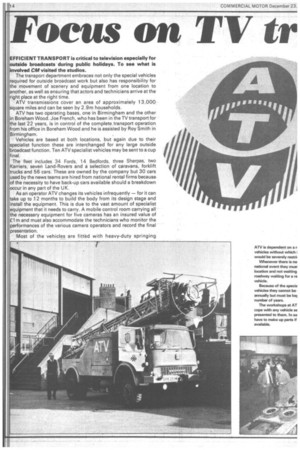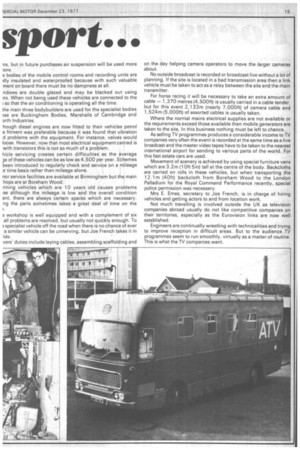Focus on TV tr
Page 16

Page 17

If you've noticed an error in this article please click here to report it so we can fix it.
sport...
EFFICIENT TRANSPORT is critical to television especially for outside broadcasts during public holidays. To see what is involved CM visited the studios.
The transport department embraces not only the special vehicles required for outside broadcast work but also has responsibility for he movement of scenery and equipment from one location to another, as well as ensuring that actors and technicians arrive at the right place at the right time.
ATV transmissions cover an area of approximately 13,000 uare miles and can be seen by 2.9m households.
ATV has two operating bases, one in Birmingham and the other in Boreham Wood. Joe French, who has been in the TV transport for he last 22 years, is in control of the complete transport operation from his office in Boreham Wood and he is assisted by Roy Smith in Birmingham.
Vehicles are based at both locations, but again due to their cialist function these are interchanged for any large outside broadcast function. Ten ATV specialist vehicles may be sent to a cup final.
The fleet includes 34 Fords, 14 Bedfords, three Shorpas, two Karriers, seven Land-Rovers and a selection of caravans, forklift trucks and 56 cars. These are owned by the company but 30 cars used by the news teams are hired from national rental firms because. of the necessity to have back-up cars available should a breakdown occur in any part of the UK.
As an operator ATV changes its vehicles infrequently — for it can take up to .12 months to build the body from its design stage and nstall the equipment. This is due to the vast amount of specialist equipment that it needs to carry. A mobile control room carrying all the necessary equipment for five cameras has an insured value of El m and must also accommodate the technicians who monitor the performances of the various camera operators and record the final presentation.
Most of the vehicles are fitted with heavy-duty springing ns, but in future purchases air suspension will be used more lore.
a bodies of the mobile control rooms and recording units are )1Iy insulated and waterproofed because with such valuable ment on board there must be no dampness at all.
ndows are double glazed and may be blacked out using )rs. When not being used these vehicles are connected to the ; so that the air conditioning is operating all the time.
the main three bodybuilders are used for the specialist bodies ese are Buckingham Bodies, Marshalls of Cambridge and prth Industries.
hough diesel engines are now fitted to their vehicles petrol e fitment was preferable because it was found that vibration d problems with the equipment. For instance, valves would loose. However, now that most electrical equipment carried is with transistors this is not so much of a problem.
hide servicing creates certain difficulties as the average ge of these vehicles can be as low as 4,500 per year. Schemes been introduced to regularly check and service on a mileage )1time basis rather than mileage alone.
nor service facilities are available at Birmingham but the main hops are at Boreham Wood.
nning vehicles which are 10 years old causes problems Ise although the mileage is low and the overall condition ant, there are always certain spares which are necessary. ng the parts sometimes takes a great deal of time on the
e workshop is well equipped and with a complement of six all problems are resolved, but usually not quickly enough. To specialist vehicle off the road when there is no chance of ever a similar vehicle can be unnerving, but Joe French takes it in .ide.
vers duties include laying cables, assembling scaffolding and on the day helping camera operators to move the larger cameras about.
No outside broadcast is recorded or broadcast live without a lot of planning. If the site is located in a bad transmission area then a link vehicle must be taken to act as a relay between the site and the main transmitter.
For horse racing it will be necessary to take an extra amount of cable — 1,370 metres (4,500ft) is usually carried in a cable tender, but for this event 2,133m (nearly 7,000ft) of camera cable and 1,524m (5,000ft) of assorted cables is usually taken.
Where the normal mains electrical supplies are not available or the requirements exceed those available then mobile generators are taken to the site.. In this business nothing must be left to chance.
As selling TV programmes produces a considerable income to TV companies very often the event is recorded at the same time as a live broadcast and the master video tapes have to be taken to the nearest international airport for sending to various parts of the world. For this fast estate cars are used.
Movement of scenery is achieved by using special furniture vans which are 3.2m (1 Oft 5in) tall at the centre of the body. Backcloths are carried on rolls in these vehicles, but when transporting the 12.1m (40ft) backcloth from Boreham Wood to the London Palladium for the Royal Command Performance recently, special police permission was necessary.
Mrs E. Ernes, secretary to Joe French, is in charge of hiring vehicles and getting actors to and from location work.
Not much travelling is involved outside the UK as television companies abroad usually do not like competitive companies on their territories, especially as the Eurovision links are now well established.
Engineers are continually wrestling with technicalities and trying to improve reception in difficult areas. But to the audience TV programmes seem to run smoothly, virtually as a matter of routine. This is what the TV companies want.




































































